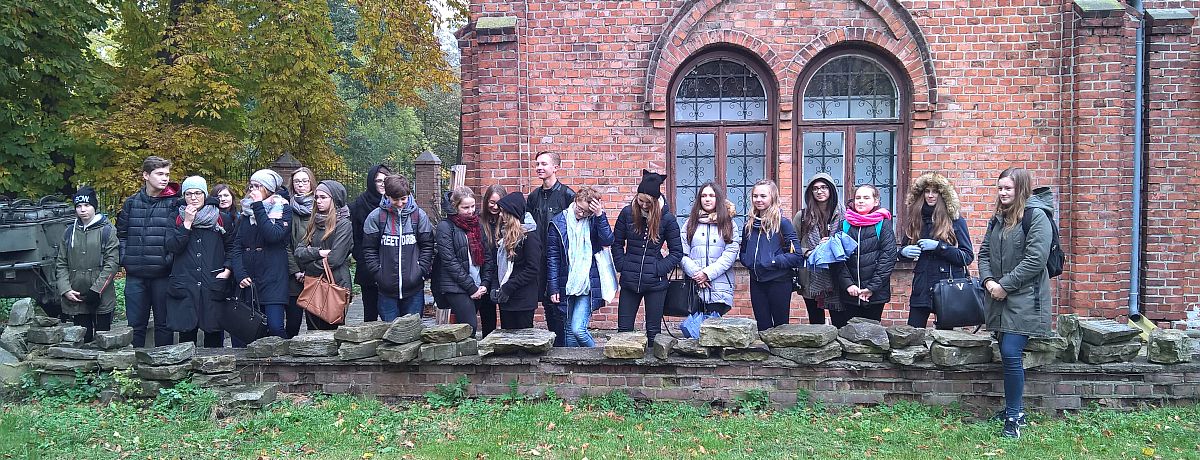| 2016 |
Brzeziny
Władysław Stanisław Reymont Junior High School


| 2016 |
Finalist at 2016 School of Dialogue Gala
Brzeziny is located in the Province of Łódź and has a population of 12,000 inhabitants. The town is located in the river valley of Mrożyca. Before the war, it was renowned for its cloth and textile manufacturing. The beginnings of the settlement of Jews in Brzeziny date back to the first half of the 16th century. By the end of the 17th century, Jews constituted around 24% of the town population, whereas at the turn of the 19th and 20th century, more than 50%. Because of the Jews who came to Brzeziny from Russia, outwork tailoring started to develop here by the end of the 19th century. The town became one of the largest tailoring centers in the eastern part of Europe. Jews living in Brzeziny were also shopkeepers, traded cattle, sold cloth in the local fairs. In September 1939, Germans took over the town, confiscated Jewish goods, burned the synagogue down. In February 1940, they set up a ghetto. About 2,000 people were sent to the camp in Chełmno, the others ended up in Łódź. Until today, there are very few sites related to the Jewish history that survived – townhouses, the Jewish cemetery, commemorative plaques.
In September and October, the junior high school in Brzeziny welcomed Ewelina Bartosik and Adam Gąsecki, Forum for Dialogue educators. For most of the students, this was the first opportunity to discuss Jewish history and culture. With each workshop, the junior high students would show a greater interest in the Jewish heritage of their home town. “I got to know this distant culture to which only few weeks before I had been indifferent. I have never presumed that I could find a different religion so interesting,” one of the workshops participants recalled.
Because of these meetings, the students were able to strengthen their awareness about the Jewish history of their town and its importance. They openly expressed their embarrassment about the state of the town houses, hardly noticeable informative plaques or littered cemetery. They decided to act – they cleaned the cemetery. They declared to organize such action each year.

Tirelessly they searched for inspiration and information in the recollections of town inhabitants. In September they visited the Regional Museum where a collection of Judaica is being displayed. They met there with Sylvie Kaptur-Gintz – a French artist. They listened to a story about her grandmother – Chuma Albert who was a seamstress in Brzeziny. She also talked about the Jewish traditions of her family. About the history of Jews of Brzeziny, their culture and customs. They also contacted Ester and Sarah Minash who live in Israel. Ester told them about Brzeziny of her childhood, where she lived until 1942. The young people prepared a surprise for them – photos and a film about today’s Brzeziny.
November 19 was a day of excitement. The students prepared a location-based game. Nine groups of three people each participated in it. For several hours, the participants were performing different tasks, while discovering the history of Jewish townhouses, the synagogue, the pre-war cinema owned by Maurycy Frankenstein, or the cemetery at the same time. The game involved solving puzzles, questions and crossroads. It ended at school.
Here, a sweet snack awaited cold participants. They also learned about the results of the game. Later, an “afternoon snack with Jewish culture” was organized. The invited guests gathered at the Regional Museum, partner of the event. They watched a multimedia presentation about the history of Jews from Brzeziny that the students had prepared, and listened to the recorded recollections of Maria Wylazłowska, a 91-year old resident of Brzeziny who talked about the prewar life in the town. The poems of Lutel Abramowicz, a local Jewish poet writing mainly about his time in the ghetto, were also recited. The junior high students also presented recollections of Fira Melamedzon-Salanska, they sang typical Jewish folk songs and prepared a dance performance. At the end, they all enjoyed a sweet snack prepared by the students: sweet teiglach pastries in honey, sweet charoset paste and Jewish apple pie.
As part of their report, the students made a film, a presentation, a questing scenario and recordings with the testimonies of the witnesses to the history.
I think that learning about the culture of people we coexist with is the basis for understanding and tolerance. We must realize that the fact that we differ does not mean we are not the same. Being different from each other is the basis of human nature, and understanding what makes us different is the first step for acceptance.
Workshops participant

School:
Władysław Stanisław Reymont Junior High School
Honorable mention:
Finalist at 2016 School of Dialogue Gala
Students:
2nd and 3rd year students
Teacher:
Marta Kacprzyk
Educators:
Ewelina Bartosik, Adam Gąsecki
In appreciation to the Conference on Jewish Material Claims Against Germany (Claims Conference) for supporting this educational program. Through recovering the assets of the victims of the Holocaust, the Claims Conference enables organizations around the world to provide education about the Shoah and to preserve the memory of those who perished.

In appreciation to Friends of the Forum for supporting the School of Dialogue educational program.
